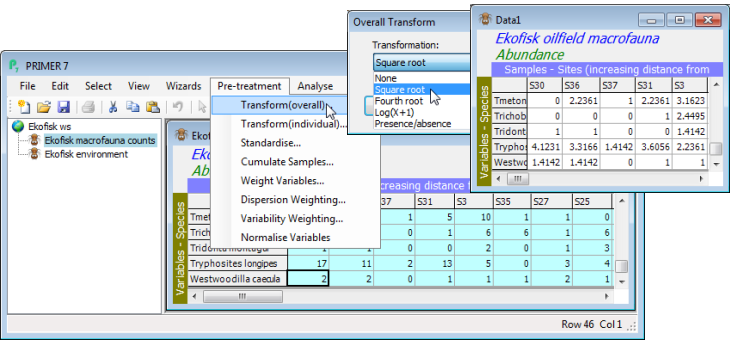Transforming (overall)
Transformation is usually applied to all the entries in an assemblage matrix of counts, biomass, % area cover etc., in order to downweight the contributions of quantitatively dominant species to the similarities calculated between samples (see Chapters 2 and 9 of CiMC). This is important for the most commonly-used resemblance measures like Bray-Curtis similarity, which do not incorporate any scaling of each species by its total or maximum across all samples. The more severe the initial transformation, the more notice is taken of the less-abundant species in the matrix. It is for the user to choose a balance between contributions of dominant and less abundant species, in the specific context, by picking from the sequence: None, Square root, Fourth root, Log(X+1) and Presence/ absence. (Reduction to presence/absence, i.e. 1/0, is thought of as a transformation since it would be the logical end-point of taking ever more severe power transforms: square root, 4th root, 8th root, …, and it is clearly one way in which less abundant species are given a similar weight to abundant ones.) If standardisation of samples by total is also required, for example to ameliorate the effects of differing sample volumes, it is logical to standardise first, then transform.
Open the previously saved workspace Ekofisk ws from the C:\Examples v7\Ekofisk macrofauna directory (or open Ekofisk macrofauna counts.pri and Ekofisk environmental.xls into a clear workspace, Section 1). Edit>Properties on the count matrix shows that 173 species were found across the 39 sites, which are ordered in increasing distance away from the oil-field centre (the putative source of a pollution gradient, diluting with distance). It is crucial to stress at this point that an initial reduction in the number of species entered into the later multivariate analyses of these samples is not required - as just remarked, it is the job of the transformation and the similarity measure to balance contributions from abundant and rarer species. However, purely in order to visualise the effect of the differing transformations, on a more manageable number of species, take Select>Variables>(•Use those that contribute at least 2 %), which selects 46 ‘most important’ species (you can see that is it 46 by clicking in the last row of the selected array, when the row and column position of the cursor will be seen at the bottom right of the PRIMER desktop). On this reduced matrix, take Pre-treatment>Transform (overall)>(Transformation:Square root), and also the options for Fourth root and Presence/absence. Rename the four ‘Datan’ sheets appropriately, e.g. by clicking twice (slowly) on their name in the Explorer tree and typing in Square root etc.

